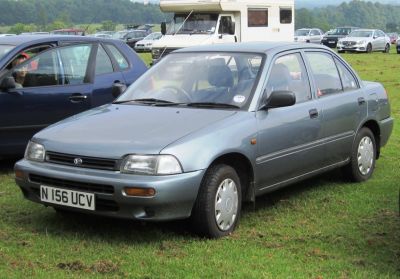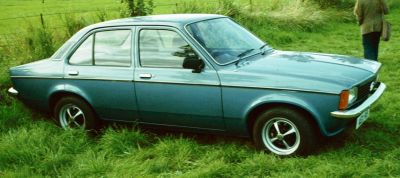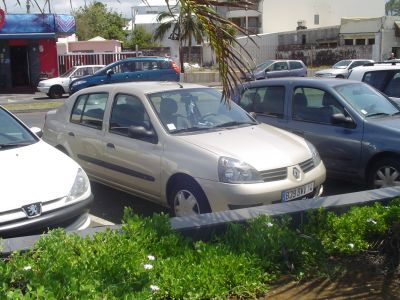 1995 Hyundai Accent I Dimensions, Size & Specs
1995 Hyundai Accent I Dimensions, Size & SpecsMeasurements of the 1995 Hyundai Accent I, engineered for optimal performance and comfort
| Dimensions | |
|---|---|
| Length: | 4117 mm162.1 in13.5 ft |
| Width: | 1620 mm63.8 in5.3 ft |
| Height: | 1394 mm54.9 in4.6 ft |
| Trunk Capacity: | 320-346 liter11.3-12.2 cu ft |
| Weight Specifications | |
| Curb Weight: | 955-970 kg2105-2138 lbs |
| Maximal permitted Weight: | 1440 kg3175 lbs |
| Tire Specifications | |
| Rims Size: |
|
| Tire Sizes: |
|
The Hyundai Accent I, produced between 1995 and 1999, is a compact sedan that offered practical dimensions ideal for urban and suburban driving. Measuring 4117 mm (161.9 inches) in length, 1620 mm (63.8 inches) in width, and 1394 mm (54.9 inches) in height, it was designed to provide a comfortable yet efficient footprint on the road. This generation of Accent sported a curb weight ranging from 955 to 970 kilograms (2105 to 2138 pounds), reflecting its lightweight build aimed at fuel efficiency. The maximum permissible weight stood at 1440 kilograms (3175 pounds). This compact sedan was equipped with 13-inch rims and tire sizes varying between 155/80 R13 and 175/70 R13, which contributed to its balanced handling and ride comfort. The Hyundai Accent I offered a luggage capacity between 320 and 346 liters (11.3 to 12.2 cubic feet), making it practical for everyday use and moderate cargo needs. These size characteristics made the Accent I a well-rounded choice in the small car segment during its production period, combining manageable exterior dimensions with sufficient interior and storage space for drivers looking for an economical and reliable vehicle.
Discover the standout features that make the 1995 Hyundai Accent I a leader in its class
Have a question? Please check our knowledgebase first.
The Hyundai Accent I sedan, produced from 1995 to 1999, has a length of 4117 mm (161.9 inches), a width of 1620 mm (63.8 inches), and a height of 1394 mm (54.9 inches). These compact dimensions position it well within the small sedan category, making it suitable for urban driving and parking where space might be limited. Its relatively narrow width and low height contribute to a streamlined profile while maintaining adequate interior space for passengers. These dimensions are typical for economy sedans of the mid-1990s and provide a good balance between maneuverability and interior comfort.
The curb weight of the Hyundai Accent I ranges from approximately 955 kg to 970 kg (2104 to 2139 lbs), depending on the specific trim and equipment. The maximum permissible weight (gross vehicle weight rating) is about 1440 kg (3175 lbs), indicating the heaviest the vehicle can safely be when fully loaded with passengers and cargo. This relatively lightweight footprint contributes to the car's fuel efficiency and nimble handling characteristics. The weight and capacity numbers reflect its position as a compact economy sedan focused on affordability and efficiency rather than heavy-duty performance or cargo hauling.
The Hyundai Accent I offers a luggage capacity ranging between 320 to 346 liters (approximately 11.3 to 12.2 cubic feet). This trunk space is adequate for daily use such as grocery shopping or luggage for short trips, typical of compact sedans from the mid-90s. While it may not match the cargo volume of larger sedans or hatchbacks, it remains competitive within its class. The relatively deep trunk helps accommodate medium-sized suitcases and bags, making it a practical option for small families or commuters needing moderate storage.
Yes, the Hyundai Accent I fits comfortably within the dimensions of a standard home garage. With a length of 4117 mm (161.9 inches) and a width of 1620 mm (63.8 inches), it is compact enough to allow for safe clearance on all sides in most single-car garages, which typically measure around 2.4 to 3 meters (8 to 10 feet) wide and 5.5 to 6 meters (18 to 20 feet) deep. Its height of 1394 mm (54.9 inches) allows it to fit easily under garage doors and typical overhead storage or lighting fixtures, providing convenience for owners who park the car indoors.
The Hyundai Accent I, produced from 1995 to 1999, is actually the first generation of the Accent model, so there is no predecessor directly named 'Accent' it replaces. However, it was Hyundai's continuation into the subcompact sedan market following smaller or differently named Hyundai hatchbacks and sedans from previous years. Compared to Hyundai’s previous small cars, the Accent I offered a slightly larger and more modern body design, with improved dimensions for passenger comfort and trunk capacity. Its length of 4117 mm (161.9 inches), width of 1620 mm (63.8 inches), and height of 1394 mm (54.9 inches) made it more competitive against other international subcompact sedans entering the 1990s market.
When compared to contemporaries like the Toyota Corolla or Honda Civic from the mid-1990s, the Hyundai Accent I is slightly smaller in all dimensions, making it a more compact and economical choice. For example, the 1995 Toyota Corolla sedan measured around 4350 mm (171.3 inches) in length and 1695 mm (66.7 inches) in width, larger than the Accent I's 4117 mm by 1620 mm footprint. This size difference translated to a lighter curb weight for the Accent I (955-970 kg) versus around 1100 kg for competitors, contributing to better fuel economy but potentially less interior space. Overall, the Accent I was designed as an affordable, efficient alternative with a smaller size advantageous for city driving, yet a bit less roomy than some mainstream rivals.
The Hyundai Accent I comes equipped with 13-inch rims, typically paired with tires sized 155/80 R13 or optionally 175/70 R13 depending on the trim level and regional configurations. The smaller 13-inch rim size is common for economy cars of this period and generally supports a comfortable ride with good tire sidewall height, which helps absorb road imperfections. The tire width of 155 mm or 175 mm provides adequate grip for the car’s relatively lightweight and moderate power output, balancing fuel efficiency and handling performance. These dimensions reflect the Accent I’s emphasis on comfort, economy, and ease of maintenance rather than sporty performance.
Although specific interior dimensions are often not detailed, the Hyundai Accent I’s compact exterior size translates to a modest but practical passenger cabin. The relatively narrow width of 1620 mm (63.8 inches) and height of 1394 mm (54.9 inches) means passengers in both front and rear seats can expect sufficient headroom and legroom typical for an economy sedan of the 1990s. The sedan body style offers a traditional three-box design, providing rear passengers with dedicated leg space separate from the cargo area. The interior layout is straightforward, optimized for efficiency and comfort, suitable for small families or commuters.
As Hyundai’s first-generation Accent, the 1995-1999 model launched the nameplate’s reputation for affordable economy cars. While it incorporated solid engineering for its time, it lacks the advanced environmental and technological features found in later generations. It primarily featured conventional carbureted or early EFI small displacement engines, resulting in moderate fuel economy and emissions by today's standards. Technology such as airbags, ABS, and advanced infotainment were rudimentary or optional. Later generations improved significantly with more efficient powertrains, safety technologies, and modern conveniences. Thus, the Accent I serves mainly as an entry-level, no-frills economy sedan emblematic of its era.
Yes, the Hyundai Accent I’s compact size and dimensions make it very practical for daily commuting and city driving. Its length of just over 4.1 meters (161.9 inches) and modest width of 1.62 meters (63.8 inches) allow for easy maneuverability through congested urban streets and tight parking spaces. The lightweight design helps reduce fuel consumption, making it economical for regular use. Additionally, the sedan body style offers adequate passenger comfort and small but functional cargo space for typical day-to-day errands. Overall, the Accent I’s size and engineering make it an ideal city car for drivers seeking efficiency, ease of parking, and affordable ownership.
Discover similar sized cars.

| Production: | 1994-2000 |
|---|---|
| Model Year: | 1994 |
| Length: | 4085 mm160.8 in |
| Width: | 1620 mm63.8 in |
| Height: | 1390 mm54.7 in |

| Production: | 1973-1979 |
|---|---|
| Model Year: | 1973 |
| Length: | 4124 mm162.4 in |
| Width: | 1580-1590 mm62.2-62.6 in |
| Height: | 1375-1385 mm54.1-54.5 in |

| Production: | 1994-2000 |
|---|---|
| Model Year: | 1994 |
| Length: | 4165 mm164.0 in |
| Width: | 1665 mm65.6 in |
| Height: | 1450 mm57.1 in |

| Production: | 2002-2008 |
|---|---|
| Model Year: | 2002 |
| Length: | 4171 mm164.2 in |
| Width: | 1639 mm64.5 in |
| Height: | 1437 mm56.6 in |

| Production: | 1990-2000 |
|---|---|
| Model Year: | 1990 |
| Length: | 4075 mm160.4 in |
| Width: | 1575 mm62.0 in |
| Height: | 1395 mm54.9 in |

| Production: | 1995-2004 |
|---|---|
| Model Year: | 1994 |
| Length: | 4075-4090 mm160.4-161.0 in |
| Width: | 1575 mm62.0 in |
| Height: | 1395 mm54.9 in |
